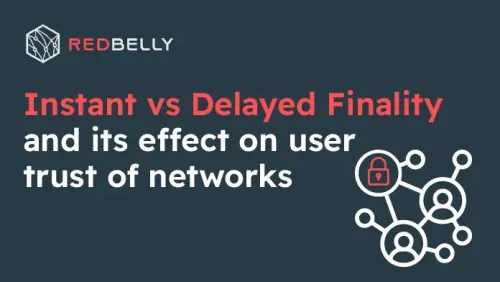Transaction throughput is a term ascribed to the number of successful transactions completed on a blockchain per second. In essence, transactions per second or TPS measures the speed of blockchain networks.
Not all blockchains have the same throughput, and there’s a reason why – the Blockchain Trilemma. It’s an age-old debate within the community of blockchain developers as to whether to prioritise decentralisation, security, or scalability at the expense of one or two of the others.
For a blockchain trying to process more complex transactions, and potentially create a decentralised means of achieving outputs akin to centralised platforms like stock exchanges, speed and scalability is crucial.
The trade-off has led to several blockchains claiming to have solved all three elements of the Blockchain Trilemma, but in reality, most have prioritised one element and sacrificed the other two. The optimal threshold is actually use case-dependent and remains a subject of ongoing debate within the Web3 community.
Is there really a way to hit all three targets? At Redbelly, we think we’ve found a way. Our TPS benchmark (660,000 TPS under lab conditions) is the result of years of research into the ideal level that should define optimal throughput, with security and decentralisation not being sacrificed in its place.

The Diablo Benchmark
The Distributed Analytical Blockchain benchmark framework, or “Diablo,” was developed by researchers from the University of Sydney and the Swiss Federal Institute of Technology in Lausanne, including Redbelly founder Vincent Gramoli.
Under Diablo, scalability was quantified as the ability to allow a large number of unprivileged users to participate in blockchain execution. The results observed across some of the competing and so-called ‘high-performance’ blockchains reveal that peak throughput was far lower than what was initially claimed. They just cannot stand up to the types of loads that a real-world market would require.
The reason for this underperformance can be explained by batching many transactions in a single client and running short benchmarks whose requests won’t clog the Mempool (unconfirmed transactions in a blockchain). At Redbelly, we believe that injecting real workloads to test these systems should be the only acceptable benchmark practice, because it flushes out some of these fundamental problems.
Sustained Throughput Without Sacrifice
The Redbelly blockchain works differently to solve these problems. It prioritises finality in a way that is truly scalable, because the nodes on the Redbelly Network are not based on a leader-based consensus like many other public blockchains. In the cases of those leader-based systems, a leader node makes the final decision on which transactions are included in the next block. Most Proof-of-Work systems, including Bitcoin, are prime examples of this type of consensus mechanism.
Unfortunately, these systems are wrought with flaws, including the fact that they are susceptible to many different types of attacks. These networks also raise the question of fairness, seeing as leaders control the order in which transactions are placed, often prioritising the highest bidder.
Flaws like these arise when onboarding high value players into Real World Asset (RWA) tokenisation, like major institutions and investors across the globe. These problems defeat the premise of a more democratised access to financial systems for the masses of Decentralised Finance (DeFi).
By comparison, Redbelly works differently. All validators in the Redbelly blockchain are collaborative, not competitive; they can make block proposals and create a superblock with no single validator winning the consensus round. In this way, we achieve sustained throughput without losing any transactions.
Using the Diabo benchmark suite, Redbelly’s transaction validation and propagation reduction (TVPR) blockchain outperformed several of the supposed ‘high-performance’ public chains under real application workloads. In fact, some of these traditional chains were so slow it’s hard to imagine how they could be a realistic Distributed Ledger Technology (DLT) solution for large businesses. Imagine companies like Uber or an exchange like NASDAQ, where transactions can’t be limited by slow speeds and spiralling costs, and under no circumstances could they ever be lost completely. That would destroy user trust and margins for those businesses, putting them at grave risk of total failure.
With our fully EVM (Ethereum Virtual Machine)-compatible network, Redbelly achieved a high throughput even in these transaction-heavy real-world scenarios. Redbelly Network was the only blockchain to successfully execute these types of workloads on a dApp without losing transactions.
Redbelly also grows in performance as more nodes join the network. Because nodes collaborate instead of competing, the Redbelly Network gains sustainability and throughput advantage, without succumbing to growing decentralisation or security risks.
A Layer 1 for RWAs
Most blockchain systems that process millions of transactions each day would be even more congested if it wasn’t for the Layer 2 networks. Layer 2 networks sit on top of the Layer 1 blockchains and bundle transactions together off-chain, acting as a hack to reduce the computation load of the underlying chain.
These Layer 2 networks were built to try and solve the scalability problem that plagues many blockchains today. This is not a sustainable solution for blockchains aspiring to process the kind of computation loads that tokenised Real World Assets (RWAs) would demand. It’s a bit like sticking a band-aid on an open wound, without trying to fix the issue that caused the bleeding in the first place. Not to mention the myriad of security and data protection issues faced in taking transactions off the Layer 1 chain and passing them to the Layer 2 and back again.
When it comes to high-value regulated assets, all transactions must be committed to the chain. Only a Layer 1 network like Redbelly, built specifically to sustain these high volumes natively, will be capable of delivering the solution required to handle these transactions. The Redbelly Network will be able to support these markets and use cases.
Interest is growing around incorporating RWA tokenisation and smart contracts to enable simultaneous settlement, automated clearing, and account transactions for financial institutions. This will be one of the key themes that drive interest in digital assets as we head into the next few years.
In 2024, we foresee a deeper integration between crypto and traditional finance centred around tokenising real world assets (RWAs).
In a world that will soon see more institutions creating digital representations of commodities, stocks, bonds, and other structured products on the blockchain, a resilient, high-speed, no transaction-loss blockchain is a necessity.
That’s why we believe that the Redbelly blockchain will be an integral part of this shift towards the next era of Web3.
Join our Discord here or follow us on X.



